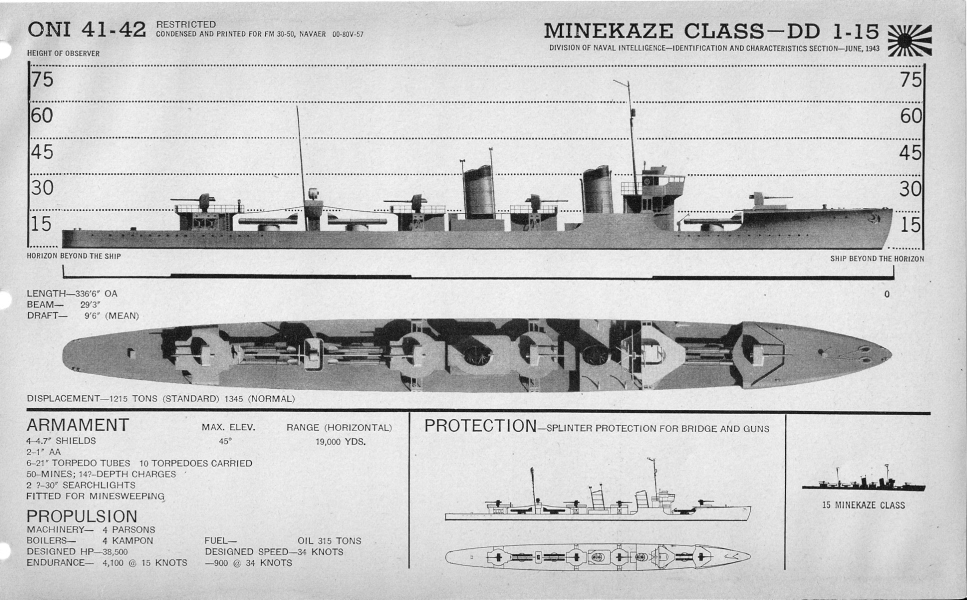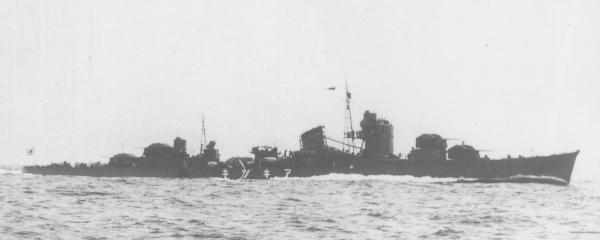|
Minekaze-class Destroyer
The was a class of fifteen 1st-class destroyers built for the Imperial Japanese Navy. Obsolete by the beginning of the Pacific War, the ''Minekaze''-class ships were then relegated to mostly secondary roles, serving throughout the war as patrol vessels, high speed transports, target control vessels, and as ''kaiten'' (suicide torpedo) carriers. Most ultimately were lost to U.S. and British submarines. The basic design of the ''Minekaze'' was used for the next three classes of Japanese destroyers, a total of 36 ships. Background Construction of the large-sized ''Minekaze''-class destroyers was authorized as part of the Imperial Japanese Navy's 8-4 Fleet Program from fiscal 1917–1920, as an accompaniment to the medium-sized with which they shared many common design characteristics. Equipped with powerful engines, these vessels were capable of high speeds and were intended as escorts for the projected s, which were ultimately never built. Two vessels were authorized in fis ... [...More Info...] [...Related Items...] OR: [Wikipedia] [Google] [Baidu] |
Maizuru Naval Arsenal
was one of four principal naval shipyards owned and operated by the Imperial Japanese Navy. History The Maizuru Naval District was established at Maizuru, Kyoto Prefecture in 1889, as the fourth of the naval districts responsible for the defense of the Japanese home islands. After the establishment of the navy base, a ship repair facility was established in 1901 with a dry dock. With the addition of equipment and facilities for ship production by 1903, the Maizuru Naval Arsenal was officially established. Additional dry docks were completed in 1904 and 1914. When the No. 3 dry dock was completed in 1914, it was the largest in Japan at the time. In 1923, after the Washington Naval Treaty, there were discussions within the Navy Ministry about closing the facility, and it was largely mothballed until 1936. Afterwards, it reopened and expanded, building ships, aircraft and weapons for the military. It specialized mostly in destroyer-size and smaller vessels. Post WW II In the po ... [...More Info...] [...Related Items...] OR: [Wikipedia] [Google] [Baidu] |
World War I
World War I (28 July 1914 11 November 1918), often abbreviated as WWI, was List of wars and anthropogenic disasters by death toll, one of the deadliest global conflicts in history. Belligerents included much of Europe, the Russian Empire, the United States, and the Ottoman Empire, with fighting occurring throughout Europe, the Middle East, Africa, the Pacific Ocean, Pacific, and parts of Asia. An estimated 9 million soldiers were killed in combat, plus another 23 million wounded, while 5 million civilians died as a result of military action, hunger, and disease. Millions more died in Genocides in history (World War I through World War II), genocides within the Ottoman Empire and in the Spanish flu, 1918 influenza pandemic, which was exacerbated by the movement of combatants during the war. Prior to 1914, the European great powers were divided between the Triple Entente (comprising French Third Republic, France, Russia, and British Empire, Britain) and the Triple A ... [...More Info...] [...Related Items...] OR: [Wikipedia] [Google] [Baidu] |
Kaiten
were crewed torpedoes and suicide craft, used by the Imperial Japanese Navy in the final stages of World War II. History In recognition of the unfavorable progress of the war, towards the end of 1943 the Japanese high command considered suggestions for various suicide craft. These suggestions were initially rejected, but later deemed necessary. Various suicide craft were developed in the Japanese Special Attack Units. For the Navy, this meant ''Kamikaze'' planes, '' Shinyo'' suicide boats, ''Kaiten'' submarines, and '' Fukuryu'' suicide divers or human mines. The ''Kamikazes'' were somewhat successful, and the second most successful were the ''Kaitens''. Research on the first Kaiten began in February 1944, followed on 25 July of the same year by the first prototype. By 1 August, an order for 100 units had been placed. Development The very first Kaiten was nothing much more than a Type 93 torpedo engine compartment attached to a cylinder that would become the pilot's c ... [...More Info...] [...Related Items...] OR: [Wikipedia] [Google] [Baidu] |
Target Ship
A target ship is a vessel — typically an obsolete or captured warship — used as a seaborne target for naval gunnery practice or for weapons testing. Targets may be used with the intention of testing effectiveness of specific types of ammunition; or the target ship may be used for an extended period of routine target practice with specialized non-explosive ammunition. The potential consequences of a drifting wreck require careful preparation of the target ship to prevent pollution, or a floating or submerged collision risk for maritime navigation. Rationale Sinking redundant warships is an effective way of testing new weapons and warships in as realistic a manner as possible. Preparation In order to meet environmental, health, and safety standards, ships now have to be thoroughly cleaned so that all dangerous material and potential contaminants (such as asbestos, refrigerants etc.) are removed. In the event of the vessel becoming an artificial reef, escape exits also hav ... [...More Info...] [...Related Items...] OR: [Wikipedia] [Google] [Baidu] |
Depth Charge
A depth charge is an anti-submarine warfare (ASW) weapon. It is intended to destroy a submarine by being dropped into the water nearby and detonating, subjecting the target to a powerful and destructive hydraulic shock. Most depth charges use high explosive charges and a fuze set to detonate the charge, typically at a specific depth. Depth charges can be dropped by ships, patrol aircraft, and helicopters. Depth charges were developed during World War I, and were one of the first viable methods of attacking a submarine underwater. They were widely used in World War I and World War II, and remained part of the anti-submarine arsenals of many navies during the Cold War, during which they were supplemented, and later largely replaced, by anti-submarine homing torpedoes. A depth charge fitted with a nuclear warhead is also known as a " nuclear depth bomb". These were designed to be dropped from a patrol plane or deployed by an anti-submarine missile from a surface ship, or a ... [...More Info...] [...Related Items...] OR: [Wikipedia] [Google] [Baidu] |
Tateyama Naval Air Station
Tateyama may refer to: People with the surname * Midori Tateyama, Japanese writer * Shohei Tateyama (born 1981), Japanese baseball player * Yoshinori Tateyama (born 1975), Japanese baseball player * Homarefuji Yoshiyuki (born 1985), Japanese sumo wrestler now known as Tateyama Oyakata Places * Mount Tate (立山), a mountain range in Toyama Prefecture, Japan * Tateyama, Toyama (立山町), a town in Toyama Prefecture, Japan * Tateyama, Chiba (館山市), a city in Chiba Prefecture, Japan * Tateyama Domain, a feudal domain under the Tokugawa shogunate, in present-day Chiba Prefecture {{Disambiguation, geo, surname Japanese-language surnames ... [...More Info...] [...Related Items...] OR: [Wikipedia] [Google] [Baidu] |
Main Battery
A main battery is the primary weapon or group of weapons around which a warship is designed. As such, a main battery was historically a gun or group of guns, as in the broadsides of cannon on a ship of the line. Later, this came to be turreted groups of similar large-caliber naval rifles. With the evolution of technology the term has come to encompass guided missiles as a vessel's principal offensive weapon, deployed both on surface ships and submarines. A main battery features common parts, ammunition, and fire control across the weapons which it comprises. Description In the age of cannon at sea, the main battery was the principal group of weapons around which a ship was designed, usually its heavies. With the coming of naval rifles and subsequent revolving gun turrets, the main battery became the principal group of heaviest guns, regardless of how many turrets they were placed in. As missiles displaced guns both above and below the water their principal group became ... [...More Info...] [...Related Items...] OR: [Wikipedia] [Google] [Baidu] |
Kampon
The was the externally operating division of the Ministry of the Navy of Japan responsible for the administration of naval vessel construction. From 1923 onward, it took on the role of a research institution for the research and development of naval technologies and engineering. This included studying and investigating existing western naval technology, developing and overseeing Japan's domestic shipbuilding and arms industries, and training officers to become naval engineers and inspectors. The bureau was dismantled along with the naval ministry in November 1945 after Japan surrendered to the Allies at the end of World War II. Taishō period weapons The Department developed various weapons during the Taishō period. These were known a "Xth Year Type" weapons, with the year being the year of the Taishō Emperor's reign (dating from 30 July 1912 - 25 December 1926). [...More Info...] [...Related Items...] OR: [Wikipedia] [Google] [Baidu] |
Bridge (ship)
The interior of the bridge of the Sikuliaq'', docked in Ketchikan, Alaska file:Wheelhouse of Leao Dos Mares.jpg, Wheelhouse on a tugboat, topped with a flying bridge The bridge, also known as the pilothouse or wheelhouse, is a room or platform of a ship from which the ship can be commanded. When a ship is under way, the bridge is manned by an officer of the watch aided usually by an able seaman acting as a lookout. During critical maneuvers the captain will be on the bridge, often supported by an officer of the watch, an able seaman on the wheel and sometimes a pilot, if required. History and etymology The compass platform of a British destroyer in the Second_World_War.html" ;"title="Battle of the Atlantic during the Second World War">Battle of the Atlantic during the Second World War with central binnacle and the voice pipes to belowdecks There are many terms for parts of a ship with functions similar to a bridge. Depending upon the design and layout of a ship, some o ... [...More Info...] [...Related Items...] OR: [Wikipedia] [Google] [Baidu] |
Forecastle
The forecastle ( ; contracted as fo'c'sle or fo'c's'le) is the upper deck of a sailing ship forward of the foremast, or, historically, the forward part of a ship with the sailors' living quarters. Related to the latter meaning is the phrase " before the mast" which denotes anything related to ordinary sailors, as opposed to a ship's officers. History and design In medieval shipbuilding, a ship of war was usually equipped with a tall, multi-deck castle-like structure in the bow of the ship. It served as a platform for archers to shoot down on enemy ships, or as a defensive stronghold if the ship were boarded. A similar but usually much larger structure, called the aftcastle, was at the aft end of the ship, often stretching all the way from the main mast to the stern. Having such tall upper works on the ship was detrimental to sailing performance. As cannons were introduced and gunfire replaced boarding as the primary means of naval combat during the 16th century, the medieval ... [...More Info...] [...Related Items...] OR: [Wikipedia] [Google] [Baidu] |


.jpg)


